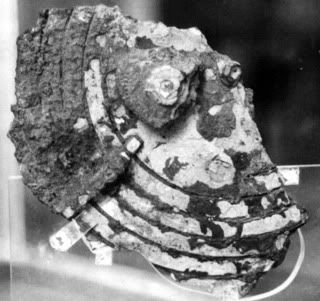The Antikythera Mechanism – An Ancient Greek Computer
 In 1974, Price published the results of more complete research based on further x-rays and gamma radiographs by Greek radiographer Christos Karakalos, as a monograph entitled Gears from the Greeks. The Antikythera mechanism, a calendar computer from ca. 80 B.C. Price’s further study had shown that the ancient scientific instrument actually contained at least 30 gears, although most of them were incomplete. However, enough of the gearing remained for Price to work out that when its handle was rotated, the mechanism was meant to show the motion of the Moon, Sun, and probably the Planets and the rising of the major stars.
In 1974, Price published the results of more complete research based on further x-rays and gamma radiographs by Greek radiographer Christos Karakalos, as a monograph entitled Gears from the Greeks. The Antikythera mechanism, a calendar computer from ca. 80 B.C. Price’s further study had shown that the ancient scientific instrument actually contained at least 30 gears, although most of them were incomplete. However, enough of the gearing remained for Price to work out that when its handle was rotated, the mechanism was meant to show the motion of the Moon, Sun, and probably the Planets and the rising of the major stars.
The device was in effect a complicated astronomical computer, a working model of the solar system, which was once been contained inside a wooden box with hinged doors to protect the mechanism inside.
Geminus of Rhodes
From the inscriptions and the position of the gears, and year-ring on the object, Price concluded that it had a close connection with Geminus of Rhodes, a Greek astronomer and mathematician who lived from approximately 110 – 40 BC. Price believed the Antikythera Mechanism to have been built and designed on Rhodes, a Greek island off coast of modern day Turkey, probably by Geminus himself around 87 BC. Indeed the shipwreck had contained storage jars from the island of Rhodes in its cargo, and was thought to have been journeying from Rhodes to Rome when it went down.
The date of the vessel’s sinking has been fairly securely tied to somewhere around 80 BC, so presuming that the object was already a few years old when it was lost, a date for the construction of the Antikythera Mechanism of around 87 BC was originally proposed, though more recent estimates center around 100 BC.
It is conceivable then, in terms of date, that the device could have been made by Geminus on the island of Rhodes, especially as Rhodes is known to have been a centre of astronomical and technological research in this era. The 2nd century BC Greek writer on mechanics, Philo of Byzantium, describes the ‘polybolos’ which he witnessed on Rhodes. This amazing ‘machine gun’ catapult, had the capacity to fire repeatedly without the need to reload, and possessed two gears linked by a chain drive powered by a windlass (a lifting device consisting of a horizontal cylinder rotated by a crank).
Rhodes was also the place where the Greek Stoic philosopher, astronomer and geographer Poseidonius (c135BC-51BC) established the nature of the tides. In addition Poseidonius made a fairly accurate, for the time, measurement of the size of the Sun, and also calculated the size and distance of the moon.
The astronomer Hipparchus of Rhodes (c190 BC – c120 BC) is credited with the invention of trigonometry and was the first to scientifically catalogue the stars’ positions. Furthermore, he was one of the first Europeans to use observations and information from Babylonian astronomy for his own research into the solar system. Perhaps elements of Hipparchus’s knowledge and ideas were used in the construction of the Antikythera Mechanism?
Reconstructing an Ancient Computer
The Antikythera device is by a long way the earliest surviving item of complex mechanical technology. The use of gear wheels over two thousand years ago is nothing less than astonishing, and its fine workmanship is as highly developed as any 18th-century clock. In recent years a number of working reconstructions of this ancient computer have been assembled, one being a partial reconstruction by Australian computer scientist Allan George Bromley (1947–2002) of the University of Sydney, together with clockmaker Frank Percival. Bromley also made more accurate x-ray images of the object which were the basis of a 3D model of the mechanism produced by his student Bernard Gardner.




